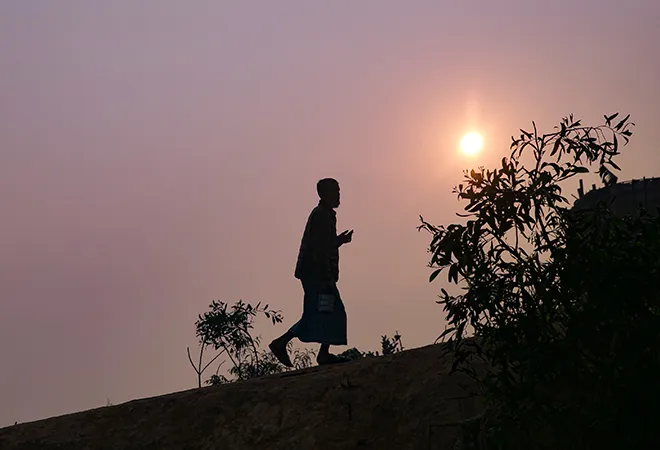-
CENTRES
Progammes & Centres
Location
The spread of coronavirus in camp areas is equivalent to spread of forest fires which only leads to more destruction — and questions the government’s efficacy and response strategy.

As universal existence comes to an abrupt halt in a bid to contain the coronavirus, one must keep in mind that for the Rohingya refugees in Bangladesh, their life is already under protracted statelessness since the 1982 citizenship act imposed by the Myanmar government. Given the scale and the magnitude of the potential threat of the virus vis-a-vis massive population density, poor condition of wash, nutrition and health capacity within the camp areas they are presently sitting on top of a volcano which has the potential to erupt at any moment. The government of Bangladesh (GoB) is trying to tackle the problem head on. The camp areas are currently under lockdown mode in an attempt to limit the reach of the invisible contagion.
As the number of cases and deaths in Bangladesh escalates, until now one case and subsequent death has been reported from Cox’s Bazar region. Resembling other developing nations under-reporting of cases owing to low testing kits remains one of the major lacunas. Bangladesh incidentally falls among four worst nations for corona test rate. Given the global trend, the numbers and death toll is likely to shoot up if not dealt with precaution as well as proper planning and adequate responses which even the most developed nations have faltered to achieve. One method of doing so is the current measure adopted i.e. lockdown.
However, declaring lockdown and enforcing one on one of the largest displaced camps in the world are two different concepts. As per the basic steps, few police posts have been created to ensure monitoring of movement and restrictions within the camp areas. The humanitarian workforce has been reduced by 80 per cent and various spaces like child and women friendly zones, education centres are closed. With about 40,000 people per square kilometer living in shacks made of bamboo and plastic side by side, which is more than 40 times the average density of Bangladesh, ensuring appropriate norms of lockdown seems quite incongruous. Maintaining social distance or quarantine where average size of one household is around seven or more persons remains a bizarre concept.
Moreover, food insecurity is already a chief concern within the camp areas. With few opportunities to produce their own food, limited financial capability, movement restrictions, protection issues, the displaced Rohingya’s remain completely dependent on food assistance by aid agencies. Despite this a recent report of World Food Programme estimates that 88 per cent of the displaced Rohingyas are considered vulnerable according to a combination of poor diversification of food as well as low consumption. Displaced Rohingyas suffering from malnutrition are easily susceptible to various infections, including COVID19 because of low immunity. In addition, the indefinite of the present lockdown creates dilemma over future shortage of food. There is growing certainty among various quarters that these people may die of hunger if not COVID19. The luxury and privilege of clean water, personal latrines and availability of soaps for regularly washing hands is not possible when displaced people are relying on communal water points and latrines where the contamination and spread of infection cannot be subsided because of the high number of users.
Furthermore, the current shutdown of services has instilled fear within the Rohingya community who has little knowledge regarding the virus since the internet and telephone network has been shut down. Minuscule or rather misinformation within the camps areas are a cause of worry which is being dealt with attempts to spread awareness via loudspeakers, posters, videos and also with assistance of few Rohingya women, men and Majhis (group leaders). Given the size of the population (close to a million) and a handful of awareness personnel, one cannot be definite if accurate information is reaching each and every individual. Misinformation and rumours have the potential to deeply aggravate the spread and impact of the virus. For instance, false rumours played a detrimental role on the response system during Ebola outbreak in West Africa. Panic led to increased transmission and subsequent death of thousands of people. Thus, precise and reliable public health messaging and knowledge is decisive in preventing and controlling outbreaks.
The current inconsistencies in services call for more urgent and rapid measures by the GoB. Three steps in this regard will be essential. Firstly, tackling food insecurity and sanitation and hygiene issues will be vital. Providing food assistance will entail concerted attention and coordinated effort between the government and humanitarian agencies since lack of nutrition will be detrimental and cause for various diseases let alone COVID19. Since this population is completely dependent for outside assistant, introducing balanced diet will be vital. Though hygiene promotion has been stepped up within the camp areas, with all humanitarian partners, ensuring that clean water and soap is readily available to all — the supply side needs to be addressed too so that there is no dearth of basic soaps as well as protective masks. As the present crisis drags on, ensuring continued services of food, soap and masks may be challenging and thus a proper plan must be chalked out from now itself.
Secondly, for effective surveillance and early detection ensuring availability of proper testing kits as well as setting up of labs having capacity to test for COVID19 within Cox’s Bazar area is indispensable. As of now, only three institutes, namely the Institute of Epidemiology, Disease Control and Research (IEDCR), Institute of Public Health(IPH), Dhaka Shishu Hospital, and Bangladesh Institute of Tropical and Infectious Disease (BITID) all based in Dhaka are facilities with the capacity to run the coronavirus test for a country of more than 164 million. Additionally, there is major requirement of PPE for the frontline doctors and nurses. Reports from various media are suggesting that doctors are sending away patients due to lack of PPEs. Thus, in Cox’s bazaar the health providers will and should not treat patients without proper protective gears which need to be ensured. Furthermore, Cox’s Bazar has only few intensive care units. With a population of more than three million in the area, more intensive units needs to be set up.
Lastly, telephone and internet network needs to be re-established to ensure seamless communication. Lack of contact will lead to major risks for the surrounding Bangladeshi communities as well. Spread of coronavirus in camp areas will be equivalent to spread of fire in Amazon forest which will only lead to more destruction and questions on the government’s efficacy and response strategy. Thus, the government needs to consider re-establishing tele-network to strengthen communication as well as awareness to help fight the outbreak. Dhaka is also presently working on a state run mobile app facilitating individuals to check for symptoms of the coronavirus disease (COVID19) by uploading a chest X-ray, with test results available through artificial intelligence within minutes. Such an app, if successful, will be helpful in the camp areas through assistance. While the status quo of the Rohingyas may not change in a while, it is vital that during such desperate occasion the displaced people do not feature at the bottom of the list.
The views expressed above belong to the author(s). ORF research and analyses now available on Telegram! Click here to access our curated content — blogs, longforms and interviews.

Sreeparna Banerjee is an Associate Fellow in the Strategic Studies Programme. Her work focuses on the geopolitical and strategic affairs concerning two Southeast Asian countries, namely ...
Read More +